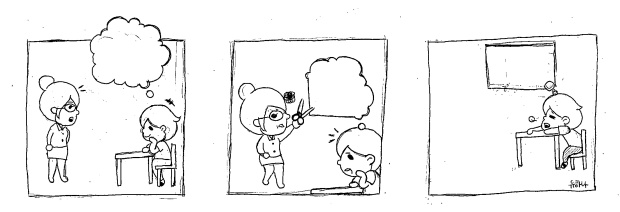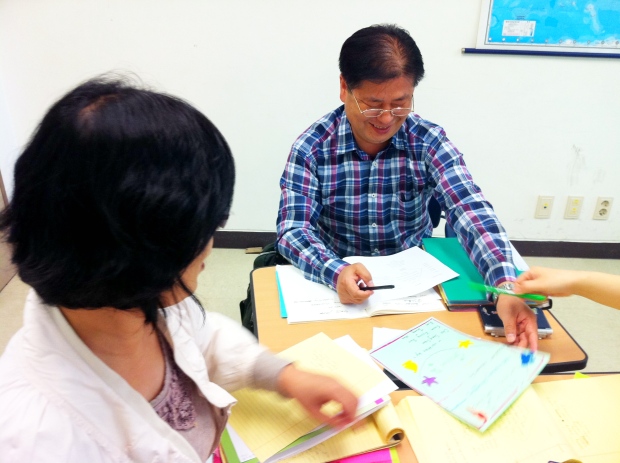This is the first of what I hope becomes a series of reflections on Parker Palmer’s, book The Courage to Teach. His book really speaks to my thoughts and feelings on what it means to teach. By “unpacking” what I read, I hope to get more insight into the often unchartered territories he deals with. They aren’t easy places to navigate, but I trust that the arrival will be worth it. I hope these explorations feed your curiosity as much as they feed mine.
————————-
Ten minutes before class. What am I supposed to teach today? Damn, I’m not ready! Who has taught this class before. Matthieu. Right. I’ll give him a call.
Damn, he isn’t answering. Oh man. Eight minutes left now.
Jon!
“Jon, can you help me out? What am I supposed to teach today?”, panicking on the phone as I scramble to find something more professional to wear. I’m still in my jeans and old t-shirt!
“No worries. It’s the end of the semester and they just need to cover this and this…”, said in the smooth, calm voice Jon always seems to have.
“Oh wow, you’re right! They only have a few classes left! Thanks Jon. I think I can handle it.”, gasping — not sighing in relief like I should be — as I think to myself, ‘How did I let this happen? Two more classes in the semester? They are going to think I’m so incompetent. I am! And man, I’m late now….’
At this point I woke up. I didn’t get a chance to see the faces of my course participants. I suppose my subconsciousness couldn’t bear seeing them.
Fear. This is what I felt when I opened my eyes. In this case, the fear of failure. At that moment, Parker Palmer’s chapter Culture of Fear I had just read a few days before, made much more sense. Even in my dreams I didn’t want to face the fear I sometimes feel. One of the points Parker Palmer makes in this chapter is how fear disconnects us from our students. Fear labels them as the lazy kid, the problem boy, the girl who can’t pay attention. When we see students like this, of course it’s hard to trust what’s inside their minds.
Fear causes this to happen:
… our assumption that students are brain-dead leads to pedagogies that deaden their brains. When we teach by dripping information into their passive forms, students who arrive in the classroom alive and well become passive consumers of knowledge and are dead on departure when they graduate. But the power of this self-fulfilling prophecy seems to elude us: we rarely consider that our students may die in the classroom because we use methods that assume they are dead.
– Parker Palmer, p.42, “The Courage to Teach“
When I first read this quote, I was inspired to write a rant blaming the Korean education system for perpetuating apathy, violence, and yes, death. This is what I first wrote:
Fear. It has a grip on us. It is all around us and so it permeates our senses and our way of being. It has become such a societal norm that we don’t even realize it’s there.
To notice fear would mean we would need to face it. To admit that fear exists would be to admit that we are doing it wrong.
And this is what I believe. I believe we are doing it wrong. When fear rules our education system, we need to set aside our pride, and look into its face. Administrators aren’t ready for this. To face their fears would also mean losing face.
That’s as far as I got. I was just about to go into tirade (Yes, trust me, it is possible.) against Korea’s old boys’ club when I started thinking of the English teachers in this system. I imagined the fear some of them have told me about: the dread of going to class and meeting students that talk back to them; the anxiety they have about the kid who is “better” at speaking English than they are; or the administrative stress of paperwork and the need to follow the demands of the system they’re in (ie: teaching the same lesson as all the other English teachers, not leaving any room for creative lesson planning; listening to parents who aren’t satisfied with the way they are teaching their kid.)
I realized I couldn’t point fingers. Not many of us want to meet fear: not administrators, not teachers… not me. Looking into fear would mean that we’d have to admit our vulnerability. And let’s face it, not many education systems out there create a safety net for vulnerability.
But here’s the twist: it’s only by facing our fears that real change is able to happen. This relates as much to a fear of heights as it does to a “fear of diversity”, “fear of conflict”, or a “fear of losing identity”: the diversity of our students’ experiences, interests and motivations; the conflict that could happen by paying attention to this diversity; and the loss of our ways of being, our ideas, and our traditions in the face of all this (The Courage to Teach, p. 38). If we want students who are happy to come to class, we will need to look at what we are doing that prevents this from happening. If teachers want to be happy when they come to class, they will need to take some time with fear.
When we remain outside our fear, we remain trapped within it.
When we, however, consciously get inside our fear, it’s as if it turns inside out. Getting inside our fear with wakeful attention and compassion actually expands our fear beyond itself. Once the contractedness at the center of fear ceases to be fueled, fear unravels, dissipates, and terminates its occupancy of us.
In entering our fear, we end our fear of it.
Through attending closely, caringly, and carefully to the particulars of our fear, we decentralize it, so that its intentions and viewpoint can no longer govern us. When the light goes on in the grottos of dread, then fear is little more than our case of mistaken identity having a bad day.
– Robert Augustus Masters, Cutting Through Personal & Collective Fear
As I ponder my own fears, I wonder if teachers and administrators will ever find a safe, communal space to attend to theirs. The idea of “decentralizing” fear in order to make room for real connections with each other is one I find incredibly appealing.
When I consider the magnitude of this healing, sitting with my own fears sounds a little less scary.
*A big thank you to Yoo Ha-na (유하나) for drawing this cartoon, and to Michael Free for asking her. And thanks to Tim Thompson, Joseph Bengivenni, James Taylor, and Arjana Blazic for helping me locate the cartoon Ha-na’s cartoon was inspired by.
Related links:
- On Being Intimate with Our Emotions -Robert Augustus Masters
- Cutting Through Personal and Collective Fear – Robert Augustus Masters
- Fear: Intuition, instincts, and awareness – Karla McLaren
- Your Emotional Vocabulary List – Karla McLaren
- Kristin Neff’s website, Self Compassion: A Healthier Way of Relating to Yourself



